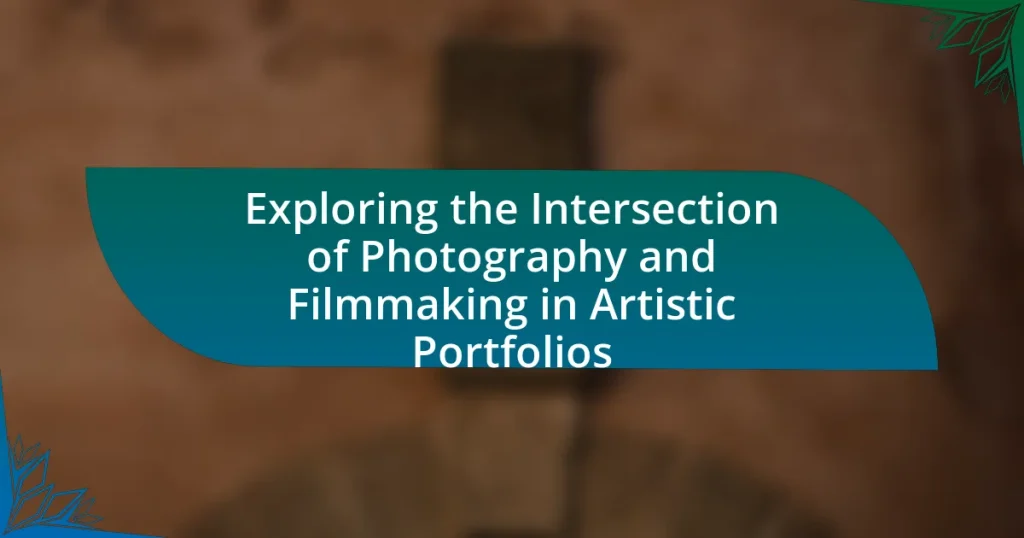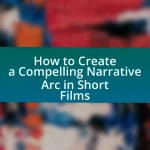The article explores the intersection of photography and filmmaking within artistic portfolios, highlighting their shared visual storytelling techniques and compositional elements. It discusses how both mediums complement each other through narrative depth, technical similarities, and the integration of diverse content, enhancing emotional engagement and audience perception. Key elements for successful portfolios include cohesive visual narratives, technical proficiency, and effective presentation strategies. The article also addresses challenges artists face when merging these mediums and offers best practices for creating impactful portfolios that leverage both photography and filmmaking skills.
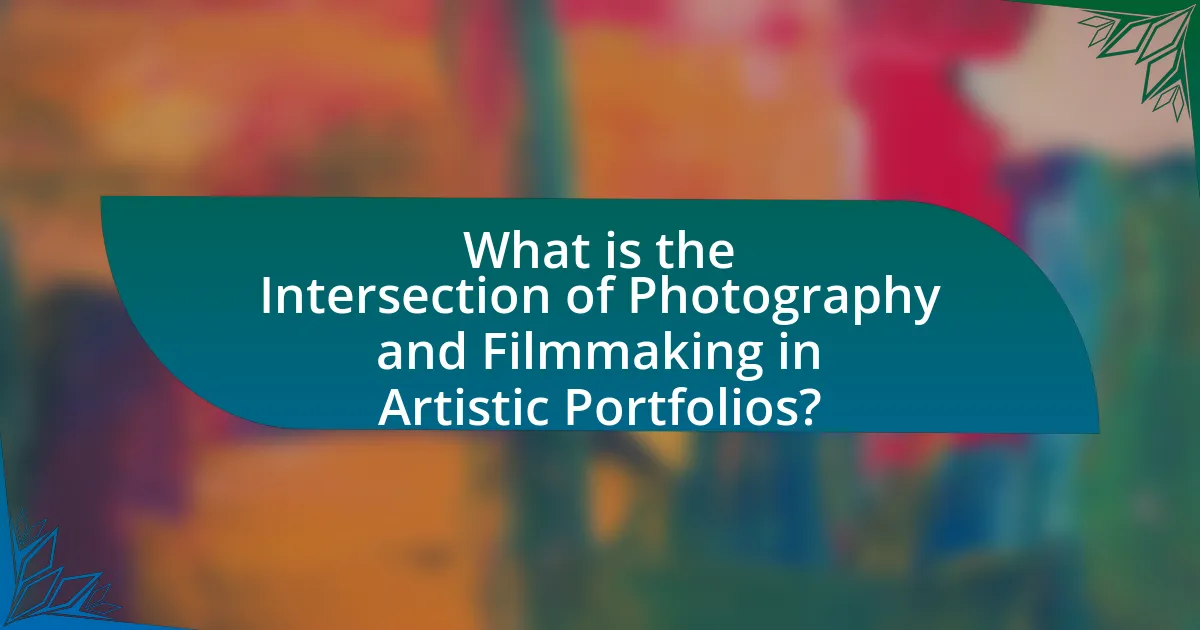
What is the Intersection of Photography and Filmmaking in Artistic Portfolios?
The intersection of photography and filmmaking in artistic portfolios lies in their shared visual storytelling techniques and compositional elements. Both mediums utilize similar principles such as framing, lighting, and narrative structure to convey emotions and messages. For instance, photographers often adopt cinematic techniques like depth of field and dynamic angles, while filmmakers incorporate still imagery to enhance visual storytelling. This blending of practices enriches artistic portfolios, allowing creators to showcase versatility and depth in their work. The integration of both forms can be seen in contemporary art exhibitions where multimedia presentations combine stills and moving images, demonstrating their interconnectedness in modern artistic expression.
How do photography and filmmaking complement each other in artistic expression?
Photography and filmmaking complement each other in artistic expression by sharing visual storytelling techniques that enhance narrative depth. Both mediums utilize composition, lighting, and framing to convey emotions and themes, allowing artists to explore complex ideas through imagery. For instance, a photograph can capture a moment’s essence, while a film can expand that moment into a broader narrative context, providing a richer experience. This synergy is evident in the works of artists like Gregory Crewdson, who blends still photography with cinematic elements to create haunting narratives, demonstrating how the two forms can inform and elevate each other in artistic portfolios.
What are the key similarities between photography and filmmaking?
Photography and filmmaking share key similarities in their reliance on visual storytelling and composition techniques. Both mediums utilize elements such as framing, lighting, and color to convey emotions and narratives. For instance, photographers and filmmakers must consider the rule of thirds and leading lines to create visually compelling images. Additionally, both disciplines require an understanding of camera settings, such as exposure and focus, to achieve desired artistic effects. This overlap in technical skills and artistic principles highlights the interconnected nature of photography and filmmaking in the realm of visual arts.
How do different techniques in photography enhance filmmaking?
Different techniques in photography enhance filmmaking by providing visual storytelling tools that improve composition, lighting, and emotional impact. Techniques such as framing, depth of field, and color theory allow filmmakers to create more engaging and visually appealing scenes. For instance, the use of shallow depth of field can isolate subjects and draw attention to key elements, while effective lighting techniques can set the mood and tone of a scene. Additionally, understanding composition principles, like the rule of thirds, helps filmmakers arrange visual elements in a way that guides the viewer’s eye and enhances narrative clarity. These photography techniques are foundational in creating a cohesive and compelling cinematic experience.
Why is the integration of photography and filmmaking important for artists?
The integration of photography and filmmaking is important for artists because it enhances storytelling and visual expression. By combining still images with motion, artists can create a more immersive narrative experience that engages audiences on multiple sensory levels. This integration allows for the exploration of themes and emotions in a dynamic way, as seen in works by artists like Cindy Sherman, who utilizes both mediums to challenge perceptions of identity. Furthermore, research indicates that multimedia presentations can increase viewer retention and emotional impact, making the fusion of photography and filmmaking a powerful tool in contemporary art.
What unique perspectives does this integration provide to audiences?
The integration of photography and filmmaking in artistic portfolios provides audiences with a multifaceted understanding of visual storytelling. This combination allows viewers to experience narratives that blend still imagery with dynamic motion, enhancing emotional engagement and depth. For instance, a portfolio that juxtaposes photographs with short film clips can convey a more comprehensive story, as each medium highlights different aspects of the subject matter. This approach not only enriches the audience’s perception but also encourages them to explore themes from various angles, fostering a deeper appreciation for the artistry involved.
How can artists leverage both mediums to tell a more compelling story?
Artists can leverage both photography and filmmaking to tell a more compelling story by using the strengths of each medium to enhance narrative depth and emotional engagement. Photography captures a single moment, allowing for powerful imagery that evokes immediate emotional responses, while filmmaking provides a dynamic narrative structure that can unfold over time, incorporating movement, sound, and dialogue. By combining these elements, artists can create a multi-layered storytelling experience that engages viewers on both visual and auditory levels. For instance, a photographic series can set the stage for a film, providing context and emotional resonance, while the film can expand on the themes presented in the photographs, creating a cohesive narrative that resonates more deeply with the audience. This synergy between still and moving images allows for a richer exploration of themes and characters, ultimately leading to a more impactful artistic expression.
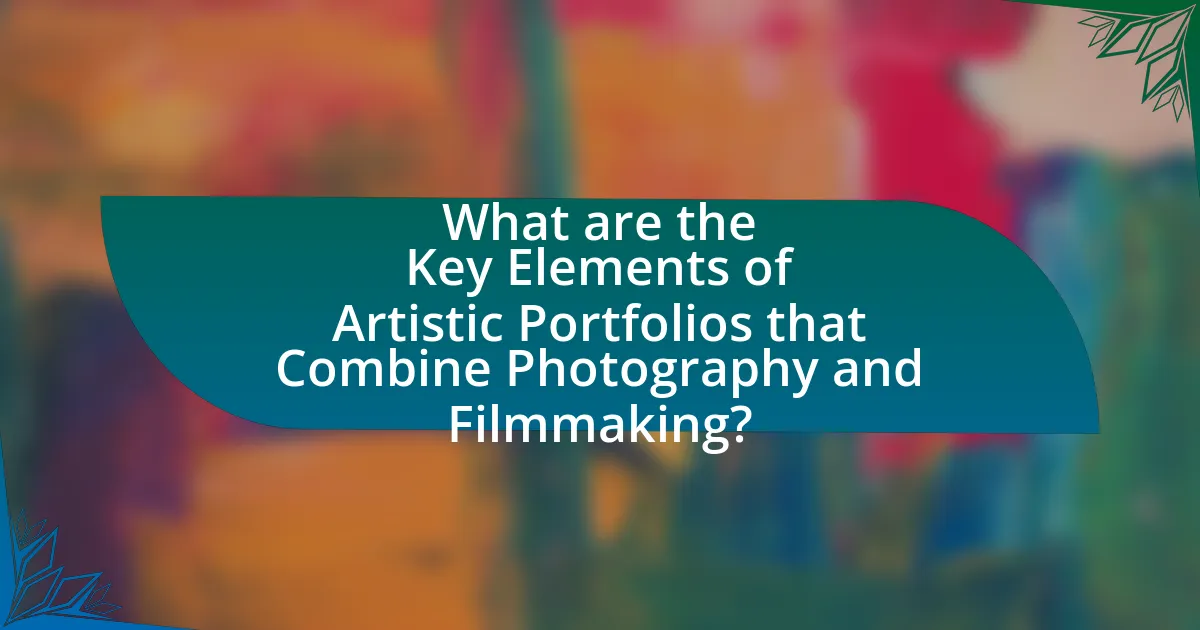
What are the Key Elements of Artistic Portfolios that Combine Photography and Filmmaking?
The key elements of artistic portfolios that combine photography and filmmaking include a cohesive visual narrative, diverse media integration, technical proficiency, and a strong personal style. A cohesive visual narrative ensures that both photography and film elements tell a unified story, enhancing the viewer’s experience. Diverse media integration allows for the seamless blending of still images and moving visuals, showcasing versatility and creativity. Technical proficiency in both mediums is essential, as it demonstrates the artist’s skill and understanding of composition, lighting, and editing techniques. Lastly, a strong personal style distinguishes the portfolio, reflecting the artist’s unique perspective and voice, which is crucial for engaging audiences and establishing a recognizable brand.
What types of content should be included in a portfolio that merges both mediums?
A portfolio that merges both photography and filmmaking should include a diverse range of content such as still images, short films, behind-the-scenes footage, and multimedia projects. Still images showcase the photographer’s ability to capture moments, while short films demonstrate storytelling through motion. Behind-the-scenes footage provides insight into the creative process, and multimedia projects can combine both mediums to create an immersive experience. This combination highlights versatility and skill in both areas, appealing to a broader audience and potential clients.
How can artists effectively showcase their photography alongside their films?
Artists can effectively showcase their photography alongside their films by creating a cohesive portfolio that integrates both mediums through thematic consistency and visual storytelling. This approach allows artists to highlight the narrative connections between their photographs and films, enhancing the viewer’s understanding of their artistic vision. For instance, using similar color palettes, subjects, or motifs across both formats can create a unified aesthetic. Additionally, artists can utilize digital platforms, such as personal websites or social media, to present their work in a visually engaging manner, allowing for interactive experiences that encourage viewers to explore the relationship between the two forms. This strategy is supported by the fact that many successful artists, such as Gregory Crewdson and Cindy Sherman, have effectively blended photography and film in their portfolios, demonstrating the potential for cross-medium storytelling.
What role does narrative play in a combined portfolio?
Narrative plays a crucial role in a combined portfolio by providing a cohesive story that connects various visual elements, enhancing the viewer’s understanding and emotional engagement. In the context of photography and filmmaking, a well-crafted narrative can guide the audience through a thematic journey, allowing them to interpret the work in a more profound way. For instance, a portfolio that integrates still images and moving footage can create a layered storytelling experience, where each medium complements the other, reinforcing the overall message. This approach is supported by studies indicating that narratives significantly increase retention and emotional response, making the combined portfolio more impactful and memorable for the audience.
How can the presentation of a portfolio impact viewer perception?
The presentation of a portfolio significantly impacts viewer perception by influencing their emotional response and evaluation of the work. A well-organized and visually appealing portfolio can create a positive impression, enhancing the perceived professionalism and creativity of the artist. Research indicates that first impressions are formed within seconds, and visual aesthetics play a crucial role in this process. For instance, a study published in the Journal of Experimental Psychology found that individuals make judgments about a person’s competence based on visual cues within just 100 milliseconds. Therefore, the arrangement, color scheme, and overall design of a portfolio can either attract or deter viewers, ultimately affecting their perception of the artist’s skills and potential.
What are the best practices for organizing visual content in a portfolio?
The best practices for organizing visual content in a portfolio include categorizing work by theme or project, maintaining a consistent visual style, and ensuring easy navigation. Categorizing work allows viewers to quickly find specific types of content, enhancing their experience. A consistent visual style across images and videos creates a cohesive narrative, making the portfolio more engaging. Easy navigation, such as clear labeling and a logical flow, helps viewers move through the content without confusion. These practices are supported by research indicating that well-organized portfolios lead to higher viewer retention and engagement rates, as seen in studies on user experience in digital media.
How does the choice of format (digital vs. print) affect the portfolio’s impact?
The choice of format, whether digital or print, significantly affects a portfolio’s impact by influencing accessibility, presentation, and audience engagement. Digital portfolios allow for broader distribution and instant access, enabling viewers to interact with multimedia elements such as videos and animations, which can enhance storytelling. In contrast, print portfolios offer a tactile experience that can evoke stronger emotional responses, as physical materials often create a sense of permanence and authenticity. Research indicates that tactile experiences can enhance memory retention, suggesting that print may leave a lasting impression on viewers. Therefore, the format chosen can shape not only how the work is perceived but also how effectively it communicates the artist’s vision.
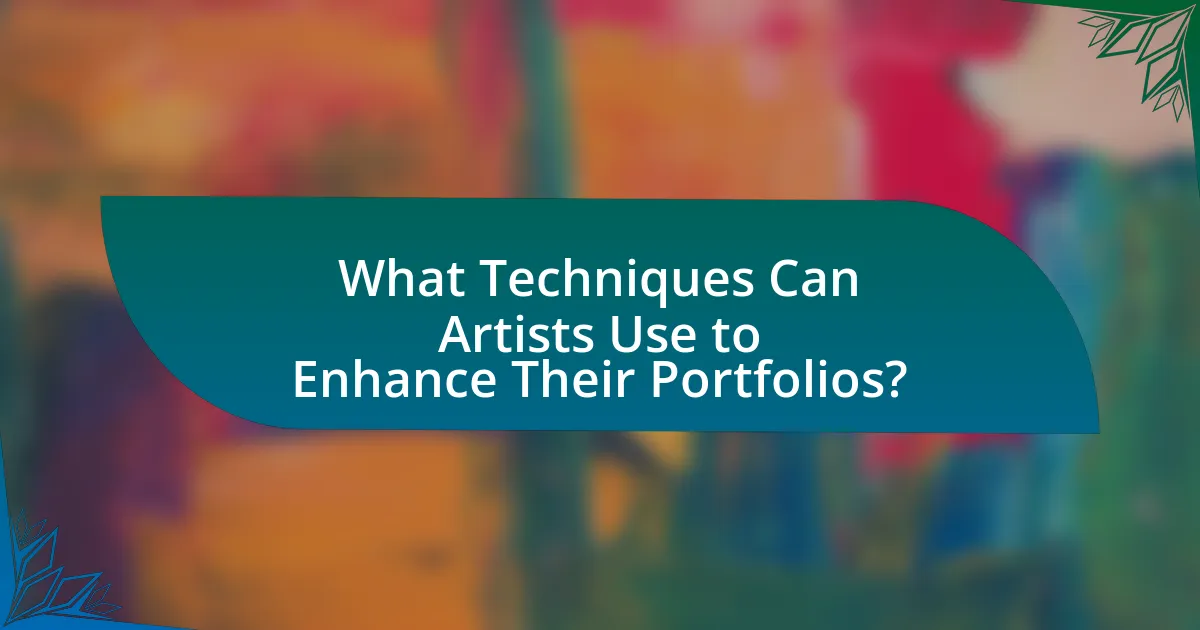
What Techniques Can Artists Use to Enhance Their Portfolios?
Artists can enhance their portfolios by incorporating diverse multimedia elements, such as combining photography and filmmaking techniques. This approach allows artists to showcase their versatility and creativity, appealing to a broader audience. For instance, integrating video clips within a digital portfolio can provide dynamic visual storytelling, which is more engaging than static images alone. Research indicates that portfolios featuring multimedia elements can increase viewer engagement by up to 60%, demonstrating the effectiveness of this technique. Additionally, artists can utilize social media platforms to share their work, gaining exposure and feedback, which further refines their portfolio.
How can artists effectively blend photography and filmmaking techniques?
Artists can effectively blend photography and filmmaking techniques by utilizing visual storytelling elements common to both mediums, such as composition, lighting, and narrative structure. For instance, photographers can incorporate cinematic techniques like depth of field and motion to create dynamic images, while filmmakers can adopt still photography principles to enhance framing and shot selection. This integration allows for a richer visual experience, as seen in works by artists like Gregory Crewdson, who combines staged photography with cinematic lighting and narrative depth, resulting in compelling imagery that evokes emotion and context.
What editing tools are most effective for integrating both mediums?
Adobe Premiere Pro and Adobe Photoshop are the most effective editing tools for integrating both photography and filmmaking. Adobe Premiere Pro allows for seamless video editing, while Adobe Photoshop provides advanced image manipulation capabilities. The integration of these tools is enhanced by their compatibility within the Adobe Creative Cloud ecosystem, enabling users to easily transfer assets between applications. This synergy facilitates the creation of cohesive artistic portfolios that blend still images and moving visuals, as evidenced by numerous professional artists who utilize both platforms to achieve a unified aesthetic in their work.
How can lighting and composition principles from photography improve film quality?
Lighting and composition principles from photography can significantly enhance film quality by creating visually compelling narratives and evoking emotional responses. Effective lighting techniques, such as three-point lighting, help to define subjects and establish mood, while composition rules like the rule of thirds guide viewer attention and create balance within the frame. For instance, films that utilize chiaroscuro lighting can generate tension and drama, similar to classic photography styles. Studies have shown that films employing strong compositional techniques often receive higher audience engagement and critical acclaim, as evidenced by the success of visually striking films like “Blade Runner 2049,” which integrates these principles to create a rich visual experience.
What are some common challenges artists face when merging these two mediums?
Artists face several common challenges when merging photography and filmmaking, primarily related to technical integration, conceptual coherence, and audience perception. The technical integration challenge arises from the differing equipment and techniques used in both mediums, requiring artists to master both photographic and cinematic skills to create a seamless blend. Conceptual coherence is another challenge, as artists must ensure that the narrative and visual elements align effectively, which can be difficult given the distinct storytelling approaches of each medium. Additionally, audience perception can pose a challenge; viewers may have preconceived notions about what constitutes photography versus filmmaking, potentially leading to confusion or misinterpretation of the artist’s intent. These challenges highlight the complexity of successfully merging photography and filmmaking in artistic portfolios.
How can artists overcome technical limitations in their portfolios?
Artists can overcome technical limitations in their portfolios by utilizing digital tools and software that enhance their work. For instance, programs like Adobe Photoshop and Lightroom allow artists to edit and manipulate images, improving quality and presentation. Additionally, artists can invest in high-quality equipment, such as cameras and lenses, which can significantly elevate the technical aspects of their photography and filmmaking. Research indicates that artists who adapt to new technologies and continuously upgrade their skills are more likely to produce compelling portfolios that attract attention and opportunities.
What strategies can be employed to maintain a cohesive artistic vision?
To maintain a cohesive artistic vision, artists should establish a clear thematic framework that guides their work. This involves defining core concepts, styles, and emotional tones that resonate throughout their photography and filmmaking. For instance, using consistent color palettes and visual motifs can create a unified aesthetic, as seen in the works of filmmakers like Wes Anderson, who employs distinctive color schemes and symmetrical compositions to reinforce his artistic identity. Additionally, regular reflection and critique of one’s work can help ensure alignment with the established vision, allowing for adjustments that maintain coherence across projects.
What are the best practices for creating a successful artistic portfolio?
The best practices for creating a successful artistic portfolio include curating a cohesive selection of work, showcasing a range of skills, and presenting high-quality images. Curating a cohesive selection ensures that the portfolio tells a clear story about the artist’s style and vision, which is essential for attracting potential clients or galleries. Showcasing a range of skills demonstrates versatility and adaptability, which are highly valued in both photography and filmmaking. Presenting high-quality images is crucial, as poor presentation can detract from the perceived value of the work; studies show that visual appeal significantly influences viewer engagement and perception of professionalism.
How can artists effectively market their combined photography and filmmaking skills?
Artists can effectively market their combined photography and filmmaking skills by creating a cohesive online portfolio that showcases both mediums. This portfolio should include high-quality images and videos that highlight their unique style and storytelling ability, making it easy for potential clients to see the versatility and creativity of their work. Additionally, leveraging social media platforms like Instagram and Vimeo allows artists to reach a broader audience, engage with followers, and share behind-the-scenes content that emphasizes their dual expertise. According to a survey by the Content Marketing Institute, 70% of marketers actively invest in content marketing, indicating that a strong online presence can significantly enhance visibility and attract clients.
What resources are available for artists looking to improve their portfolios?
Artists looking to improve their portfolios can utilize online platforms such as Behance and Adobe Portfolio, which allow for easy showcasing of visual work. These platforms provide tools for creating professional presentations and connecting with potential clients or collaborators. Additionally, resources like Skillshare and Coursera offer courses on portfolio development, covering essential skills in photography and filmmaking. According to a 2021 survey by Creative Market, 70% of artists reported that using online portfolio platforms significantly enhanced their visibility and opportunities in the creative industry.
